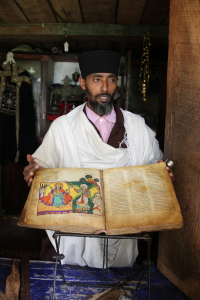Whose Openness? Whose Ethics?
Openness can be described as one of the logics driving contemporary science and culture. The mechanism behind it is quite simple: Nation-states take a part of their tax revenues and invest them to finance science and culture, in the latter field for example the digitisation of cultural heritage. In return, research organisations and cultural (heritage) institutions are obliged to publish research results and data openly accessible in order to stimulate innovation, technical progress and creativity in culture. The intention behind it is that society profits from such investment which thus serves the common good.
With respect to science, this openness strengthens a counter position against clandestine, secretive knowledge. Taking a glance back at history, it becomes obvious that this results out of the age of enlightenment in its opposition against sorcery, witchcraft, and the proclamations of the church. Confirmability, transparency, and the embedding into a system of references and a scientific community have since become the hallmarks of science. This system has flourished throughout the whole 20th century, and principles like the open accessibility of scientific literature and open data have been established since that time.
With respect to culture–and we narrow our view here onto cultural heritage–the societal value of openly accessible digital cultural heritage becomes visible if we look at e.g. the Italian public law as formulated in the “Codice dei beni culturali e paesaggio”. It defines three terms: “tutela”, which can be translated with protection, and “valorizzazione” of the cultural heritage, which means exploitation, improved access and public use, as well as valorisation. The third term, “fruizione”, aims at advancing cultural development. It provides a future-oriented perspective with the creation of new cultural works at its centre. The preservation, valorisation and creation of cultural assets are brought here into a common context that results in two essential functions: On the one hand, a backward-looking function of cultural heritage, aiming at integrating the community, and on the other hand, a forward-looking function, aiming at the cultural development of the individual and the community.[1]
However, this conception of openness and the related ethics of a common good which it aims to serve can be questioned from a non-Western perspective. Indigenous communities in Northern America have always developed, as Robin Wall Kimmerer has explained in her beautiful book “Braiding Sweetgrass”,[2] detailed botanical knowledge through century-long observation, and they have handed it over from generation to generation. Their approach resembles modern biology, but with the restriction that such knowledge may be used by the communities who elaborated it. The same may apply to traditional Chinese medicine or star maps, Aztec cosmological knowledge or land registers, Egyptian sources on building pyramids, or the Ayurvedic alternative medicine system characteristic of the Indian subcontinent. For sure, traditional scientific knowledge bound to communities resembles the knowledge collected in the secret societies of the early modern period. Craftsmen, for example, have formed guilds such as the Compagnons du Devoir which explicitly prohibited to hand over such knowledge to non-community members.[3] Contemporary indigenous communities may be criticised for their resistance to openness–but can they legitimately be challenged from a dominant Western perspective if they decide NOT to share the knowledge handed down from their ancestors to them?

Ethiopian-orthodox Priest. Photo (c) Jörg Lehmann
In a similar vein, the ideology and practices driving the digitisation of cultural heritage can be questioned. The Ethiopian Orthodox Church, for example, has a completely different understanding of what has to be understood as an “original” and a “copy”. The ark of the covenant, a legendary artefact containing the ten commandments, is said to have been given to Moses by God. To date, it is a sacred text of the Ethiopian Orthodox Church, and each copy of it equals the original–holiness stays with the text, not with the material. While this logic is in itself interesting in its opposition to the Western reverence of the original, this does not imply that digitisation is embraced. Rather, the digitisation of manuscripts relevant for the spiritual life of an Ethiopian community may be denied following an argument which underlines the relevance of cultural heritage for the integration of the community. Each member of such a community has therefore a word to say with respect to the use of such archival material: “The assumption is that any collection of manuscripts is the property of the entire community, both lay and ecclesiastical, and the opposition of even a single member may bring all digitisation activity to a sudden halt.” In other words: communities’ identities might be endangered by enforced openness.
Such a conception presents a strong counter position to the emphasis on openness prevailing in contemporary Western societies. It not only testifies an ethics which has to be respected by the all-embracing endeavour to make cultural resources available in digital form and to provide access to each and everybody. It also marks a notable resistance to contribute to the success of modernity’s minority-devouring project which has sometimes led to the silencing of communities by way of integration. From such a perspective, digitisation may be seen as the angel of the apocalypse, rather than the torch of enlightenment.
[1] For further explanations see Sophie-Charlotte Lenski (2013). Öffentliches Kulturrecht: Materielle und immaterielle Kulturwerke zwischen Schutz, Förderung und Wertschöpfung, Tübingen: Mohr Siebeck, pp.299–316.
[2] Robin Wall Kimmerer (2013). Braiding Sweetgrass: Indigenous Wisdom, Scientific Knowledge, and the Teachings of Plants, Minneapolis: Milkweed Editions.
[3] See the passage referring to Article 49 of their régime in Günther Binding, Baubetrieb im Mittelalter, Darmstadt: Wissenschaftliche Buchgesellschaft 1993, p.116.
Leave a Reply
Want to join the discussion?Feel free to contribute!